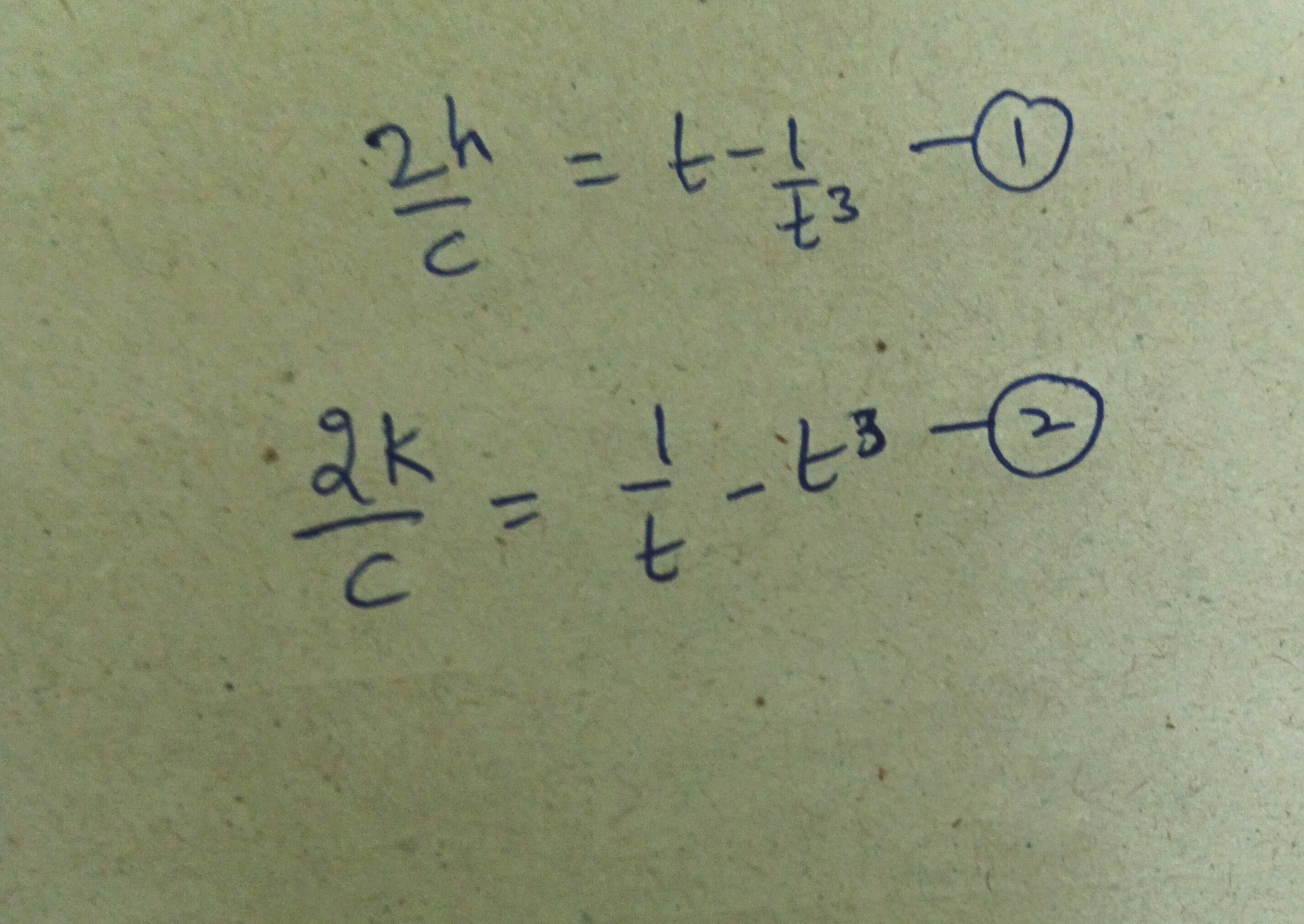Question
Question: $\frac{2h}{c} = t - \frac{1}{t^3}$ ① $\frac{2k}{c} = \frac{1}{t} - t^3$ ②...
c2h=t−t31 ①
c2k=t1−t3 ②

c^2 (h^2 - k^2)^2 + 4h^3 k^3 = 0
Solution
Let the given equations be:
- c2h=t−t31
- c2k=t1−t3
Let A=c2h and B=c2k. The equations become:
A=t−t31
B=t1−t3
We can rewrite the second equation as B=t3t2−t3. This doesn't look useful. Let's rewrite the second equation as B=t1−t3.
Consider multiplying the first equation by t3:
At3=t4−1
Consider multiplying the second equation by t:
Bt=1−t4
From these two equations, we see that At3=−(Bt).
At3+Bt=0
t(At2+B)=0
Assuming t=0 (otherwise the original expressions are undefined), we must have:
At2+B=0
Substitute back A=c2h and B=c2k:
(c2h)t2+(c2k)=0
c2(ht2+k)=0
Since c=0, we have:
ht2+k=0
If h=0, we can write t2=−hk.
Now substitute t2=−k/h into the original equations. From equation ①:
c2h=t−t31=t−t⋅t21=t−t(−k/h)1=t+kth
c2h=t+kth
Multiply by kt:
c2hkt=kt2+h
Substitute t2=−k/h:
c2hkt=k(−hk)+h=−hk2+h=hh2−k2
c2hkt=hh2−k2
2hk2t=c(h2−k2)
If h=0 and k=0, we can solve for t:
t=2hk2c(h2−k2)
Square both sides:
t2=(2hk2c(h2−k2))2=4h2k4c2(h2−k2)2
We also have t2=−hk. Equating the two expressions for t2:
−hk=4h2k4c2(h2−k2)2
Assuming h=0 and k=0, multiply both sides by 4h2k4:
−k(4hk4)=c2(h2−k2)2h
−4hk5=c2h(h2−k2)2
If h=0, we can divide by h:
−4k5=c2(h2−k2)2
This equation must hold if a value of t exists.
Let's check the case h=0.
If h=0, the first equation becomes c2(0)=t−t31, so 0=t−t31, which implies t4=1. The second equation is c2k=t1−t3. If t4=1, then t=±1 or t=±i.
If t=1, c2k=1−13=0, so k=0. If t=−1, c2k=−11−(−1)3=−1−(−1)=0, so k=0. If t=i, c2k=i1−i3=−i−(−i)=0, so k=0. If t=−i, c2k=−i1−(−i)3=i−(i)=0, so k=0. So, if h=0, then k=0.
Let's check if h=0,k=0 satisfies the derived relation −4k5=c2(h2−k2)2.
−4(0)5=c2(02−02)2
0=c2(0)2
0=0. So the relation holds for h=0,k=0.
The derived relation is −4k5=c2(h2−k2)2. This can be rewritten as c2(h2−k2)2+4k5=0.
Let's verify this relation using the expression for t. We have t2=−k/h. Substitute this into the first equation:
c2h=t−t31=t(1−t41)
c2h=t(1−(t2)21)=t(1−(−k/h)21)=t(1−k2h2)=t(k2k2−h2)
c2h=−t(k2h2−k2)
t=−c2hh2−k2k2=c(k2−h2)2hk2
This matches the expression for t we found earlier: t=2hk2c(h2−k2).
c(k2−h2)2hk2=2hk2c(h2−k2)
(2hk2)2=c2(k2−h2)(h2−k2)
4h2k4=c2(−(h2−k2))(h2−k2)
4h2k4=−c2(h2−k2)2
c2(h2−k2)2+4h2k4=0
Let's recheck the step t2=−hk.
ht2+k=0. This step is correct.
Let's look at the second equation:
c2k=t1−t3=t1(1−t4)=t1(1−(t2)2)=t1(1−(−k/h)2)=t1(1−h2/k2)=t1(k2k2−h2)
c2k=t1(k2k2−h2)
t=2kc(k2k2−h2)=2k3c(k2−h2)
Equating the two expressions for t:
2hk2c(h2−k2)=2k3c(k2−h2)
Assuming c=0, h=0, k=0:
hk2h2−k2=k3k2−h2
hk2h2−k2=−k3h2−k2
hk2h2−k2+k3h2−k2=0
(h2−k2)(hk21+k31)=0
(h2−k2)(hk3k+h)=0
This implies either h2−k2=0 or k+h=0.
h2=k2 or h=−k. If h2=k2, then h=±k.
If h=k, then h2−k2=0. If h=−k, then h2−k2=(−k)2−k2=0.
So, if h2=k2, the equation (h2−k2)(hk3k+h)=0 is satisfied.
In this case, t2=−k/h=−k/(±k)=∓1. If h=k, t2=−1. The equations become:
c2h=t−t31
c2h=t1−t3
So t−t31=t1−t3.
t+t3=t1+t31.
t(1+t2)=t31(t2+1).
Since t2=−1, t2+1=0. So t(0)=t31(0), which is 0=0.
This means if t2=−1 (i.e., t=±i), then t−1/t3=1/t−t3. If t=i, i−1/i3=i−(−1/i)=i+1/i=i−i=0. 1/i−i3=−i−(−i)=0. So c2h=0, which means h=0. But we assumed h=k, so k=0.
This leads back to the h=0,k=0 case, which means t4=1. But here we got t2=−1, so t4=1. This is consistent. So if h=k, the relationship is h=k=0.
If h=−k, then t2=−k/(−k)=1. The equations become:
c2h=t−t31
c−2h=t1−t3
So c2h+c2h=(t−t31)+(t1−t3)=t+t1−(t3+t31).
c4h=t+t1−(t3+t31).
If t2=1, then t=±1. If t=1, c4h=1+1−(1+1)=0, so h=0. Since h=−k, k=0. This is the h=0,k=0 case again. If t=−1, c4h=−1+−11−((−1)3+(−1)31)=−1−1−(−1−1)=−2−(−2)=0, so h=0. Since h=−k, k=0. This is the h=0,k=0 case again.
The relation c2(h2−k2)2+4h2k4=0 was derived assuming h=0,k=0. Let's look at the derived relation c2(h2−k2)2+4k5=0, derived from equating the expressions for t2. This relation holds for h=0. We checked that it holds for h=0,k=0.
What if k=0 and h=0? If k=0, the second equation is c2(0)=t1−t3, so 0=t1−t3, which means t4=1. The first equation is c2h=t−t31. If t4=1, then t31=t3t4t31=t. So c2h=t−t=0, which means h=0. This contradicts the assumption h=0. So, if k=0, we must have h=0.
The only case where the equations are satisfied is h=0,k=0 with t4=1, unless there is a general relation between h,k,c that holds for any valid t.
Let's re-examine At2+B=0.
c2ht2+c2k=0⟹ht2+k=0.
If h=0, t2=−k/h. We need another expression involving t2 or t4 or some power of t that can be related to −k/h.
Consider At3=t4−1 and Bt=1−t4. At3=−(Bt). t(At2+B)=0. At2+B=0 (assuming t=0).
c2ht2+c2k=0.
ht2+k=0.
If c2(h2−k2)2+4h3k3=0, can we find a t?
If h=0, then c2(−k2)2=0⟹c2k4=0⟹k=0. If h=k=0, the original equations are 0=t−1/t3 and 0=1/t−t3, which means t4=1. So any t with t4=1 works when h=k=0.
If h=0, then t2=−k/h. The relation c2(h2−k2)2=−4h3k3 implies that if h and k have the same sign (and are non-zero), then h3k3>0, so −4h3k3<0. Also (h2−k2)2≥0 and c2>0. So c2(h2−k2)2≥0. The equation c2(h2−k2)2=−4h3k3 can only hold if both sides are zero. This happens if h2−k2=0 AND h3k3=0. h3k3=0 implies h=0 or k=0. If h=0, then k=0 (from h2−k2=0). If k=0, then h=0 (from h2−k2=0). So, if h and k have the same sign (and are non-zero), the equation c2(h2−k2)2+4h3k3=0 only holds if h=k=0.
What if h and k have opposite signs? Let k=−m where m>0. Assume h>0. c2(h2−(−m)2)2+4h3(−m)3=0 c2(h2−m2)2−4h3m3=0 c2(h2−m2)2=4h3m3. The left side is ≥0. The right side is >0 if h>0,m>0. In this case, t2=−k/h=−(−m)/h=m/h>0. So t is real.
The expression for t derived from equation ① is t=2h2kc(h2−k2). The expression for t derived from equation ② is t=2kh2c(h2−k2). These two expressions for t are identical.
The substitution of t2=−k/h into the expression for t should lead to an identity. t=2h2kc(h2−k2). t2=4h4k2c2(h2−k2)2. We must have t2=−k/h. 4h4k2c2(h2−k2)2=−hk. c2(h2−k2)2h=−k(4h4k2). c2(h2−k2)2h=−4h4k3. Assuming h=0, c2(h2−k2)2=−4h3k3.
c2(h2−k2)2+4h3k3=0.
